Search
- Page Path
- HOME > Search
- [English]
- Optimization of VIGA Process Parameters for Power Characteristics of Fe-Si-Al-P Soft Magnetic Alloy using Machine Learning
- Sung-Min Kim, Eun-Ji Cha, Do-Hun Kwon, Sung-Uk Hong, Yeon-Joo Lee, Seok-Jae Lee, Kee-Ahn Lee, Hwi-Jun Kim
- J Powder Mater. 2022;29(6):459-467. Published online December 1, 2022
- DOI: https://doi.org/10.4150/KPMI.2022.29.6.459

- 755 View
- 13 Download
-
 Abstract
Abstract
 PDF
PDF Soft magnetic powder materials are used throughout industries such as motors and power converters. When manufacturing Fe-based soft magnetic composites, the size and shape of the soft magnetic powder and the microstructure in the powder are closely related to the magnetic properties. In this study, Fe-Si-Al-P alloy powders were manufactured using various manufacturing process parameter sets, and the process parameters of the vacuum induction melt gas atomization process were set as melt temperature, atomization gas pressure, and gas flow rate. Process variable data that records are converted into 6 types of data for each powder recovery section. Process variable data that recorded minute changes were converted into 6 types of data and used as input variables. As output variables, a total of 6 types were designated by measuring the particle size, flowability, apparent density, and sphericity of the manufactured powders according to the process variable conditions. The sensitivity of the input and output variables was analyzed through the Pearson correlation coefficient, and a total of 6 powder characteristics were analyzed by artificial neural network model. The prediction results were compared with the results through linear regression analysis and response surface methodology, respectively.
- [Korean]
- Improvement of the Mechanical Property and Corrosion Resistivity of the Ni-/Fe-based Hybrid Coating Layer using High-velocity Oxygen Fuel Spraying by Heat Treatment
- Jungjoon Kim, Yeonjoo Lee, Song-Yi Kim, Jong-Jae Lee, Jae-hun Kim, Seok-Jae Lee, Hyunkyu Lim, Min-Ha Lee, Hwi-Jun Kim, Hyunjoo Choi
- J Powder Mater. 2022;29(3):240-246. Published online June 1, 2022
- DOI: https://doi.org/10.4150/KPMI.2022.29.3.240
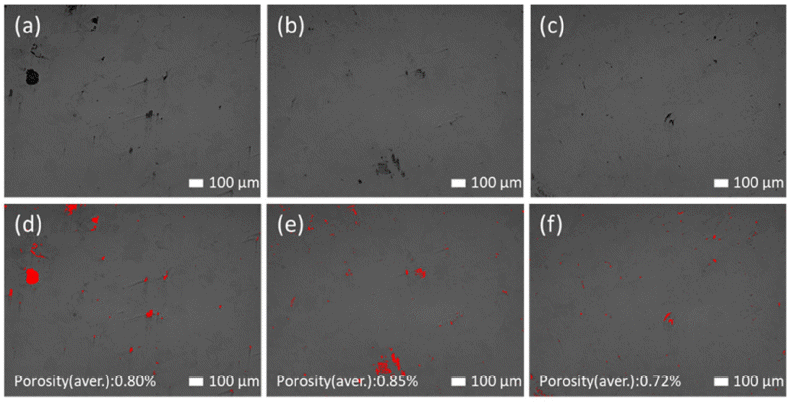
- 755 View
- 5 Download
-
 Abstract
Abstract
 PDF
PDF Novel Ni- and Fe-based alloys are developed to impart improved mechanical properties and corrosion resistance. The designed alloys are manufactured as a powder and deposited on a steel substrate using a high-velocity oxygen-fuel process. The coating layer demonstrates good corrosion resistance, and the thus-formed passive film is beneficial because of the Cr contained in the alloy system. Furthermore, during low-temperature heat treatment, factors that deteriorate the properties and which may arise during high-temperature heat treatment, are avoided. For the heattreated coating layers, the hardness increases by up to 32% and the corrosion resistance improves. The influence of the heat treatment is investigated through various methods and is considered to enhance the mechanical properties and corrosion resistance of the coating layer.
- [Korean]
- Development of Amorphous Iron Based Coating Layer using High-velocity Oxygen Fuel (HVOF) Spraying
- Jungjoon Kim, Song-Yi Kim, Jong-Jae Lee, Seok-Jae Lee, Hyunkyu Lim, Min-Ha Lee, Hwi-Jun Kim, Hyunjoo Choi
- J Korean Powder Metall Inst. 2021;28(6):483-490. Published online December 1, 2021
- DOI: https://doi.org/10.4150/KPMI.2021.28.6.483
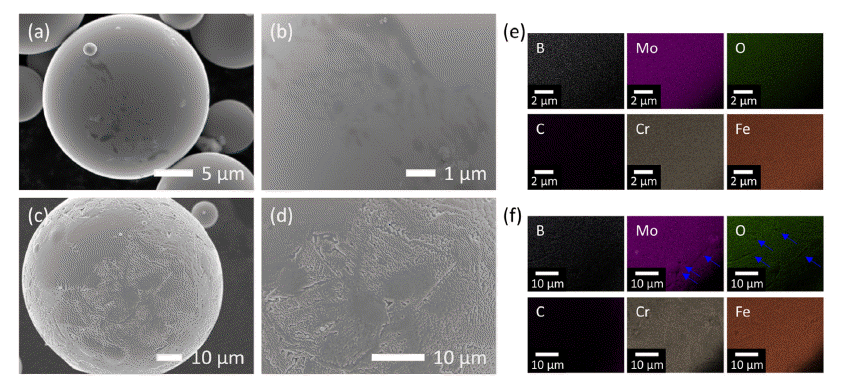
- 633 View
- 5 Download
-
 Abstract
Abstract
 PDF
PDF A new Fe-Cr-Mo-B-C amorphous alloy is designed, which offers high mechanical strength, corrosion resistance as well as high glass-forming ability and its gas-atomized amorphous powder is deposited on an ASTM A213-T91 steel substrate using the high-velocity oxygen fuel (HVOF) process. The hybrid coating layer, consisting of nanocrystalline and amorphous phases, exhibits strong bonding features with the substrate, without revealing significant pore formation. By the coating process, it is possible to obtain a dense structure in which pores are hardly observed not only inside the coating layer but also at the interface between the coating layer and the substrate. The coating layer exhibits good adhesive strength as well as good wear resistance, making it suitable for coating layers for biomass applications.
- [Korean]
- Development of Hybrid Insulating Coating for Fe-based Soft Magnetic Powder
- Jungjoon Kim, Sungyeom Kim, Youngkyun Kim, Taesuk Jang, Hwi-jun Kim, Youngjin Kim, Hyunjoo Choi
- J Korean Powder Metall Inst. 2021;28(3):233-238. Published online June 1, 2021
- DOI: https://doi.org/10.4150/KPMI.2021.28.3.233

- 539 View
- 6 Download
-
 Abstract
Abstract
 PDF
PDF Iron-based amorphous powder attracts increasing attention because of its excellent soft magnetic properties and low iron loss at high frequencies. The development of an insulating layer on the surface of the amorphous soft magnetic powder is important for minimizing the eddy current loss and enhancing the energy efficiency of highfrequency devices by further increasing the electrical resistivity of the cores. In this study, a hybrid insulating coating layer is investigated to compensate for the limitations of monolithic organic or inorganic coating layers. Fe2O3 nanoparticles are added to the flexible silicon-based epoxy layer to prevent magnetic dilution; in addition TiO2 nanoparticles are added to enhance the mechanical durability of the coating layer. In the hybrid coating layer with optimal composition, the decrease in magnetic permeability and saturation magnetization is suppressed.
- [English]
- Effects of Precipitates and Oxide Dispersion on the High-temperature Mechanical Properties of ODS Ni-Based Superalloys
- GooWon Noh, Young Do Kim, Kee-Ahn Lee, Hwi-Jun Kim
- J Korean Powder Metall Inst. 2020;27(1):8-13. Published online February 1, 2020
- DOI: https://doi.org/10.4150/KPMI.2020.27.1.8

- 1,600 View
- 30 Download
- 2 Citations
-
 Abstract
Abstract
 PDF
PDF In this study, we investigated the effects of precipitates and oxide dispersoids on the high-temperature mechanical properties of oxide dispersion-strengthened (ODS) Ni-based super alloys. Two ODS Ni-based super alloy rods with different chemical compositions were fabricated by high-energy milling and hot extrusion process at 1150 °C to investigate the effects of precipitates on high-temperature mechanical properties. Further, the MA6000N alloy is an improvement over the commercial MA6000 alloy, and the KS6000 alloy has the same chemical composition as the MA6000 alloy. The phase and microstructure of Ni-based super alloys were investigated by X-ray diffraction and scanning electron microscopy. It was found that MC carbide precipitates and oxide dispersoids in the ODS Ni-based super alloys developed in this study may effectively improve high-temperature hardness and creep resistance.
-
Citations
Citations to this article as recorded by- Mechanical Properties and Residual Stress Analysis of ODS Ni Superalloy Fabricated by Laser Powder Bed Fusion Process
Dong Wan Lee, Su Gwan Lee, Cong Dhin Van, Cae Ryeong Kim, Jin Chun Kim, Hwi Jun Kim, Joong Gyeong Lim, Tae Sik Yoon
Journal of the Japan Society of Powder and Powder Metallurgy.2025; 72(Supplement): S453. CrossRef - Additive manufacturing of oxide-dispersion strengthened alloys: Materials, synthesis and manufacturing
Markus B. Wilms, Silja-Katharina Rittinghaus, Mareen Goßling, Bilal Gökce
Progress in Materials Science.2023; 133: 101049. CrossRef
- Mechanical Properties and Residual Stress Analysis of ODS Ni Superalloy Fabricated by Laser Powder Bed Fusion Process
- [Korean]
- Effect of post heat treatment on fatigue properties of EBM 3D-printed Ti-6Al-4V alloy
- Young-Sin Choi, Ji-Hoon Jang, Gun-Hee Kim, Chang-Woo Lee, Hwi-Jun Kim, Dong-Geun Lee
- J Korean Powder Metall Inst. 2018;25(4):340-345. Published online August 1, 2018
- DOI: https://doi.org/10.4150/KPMI.2018.25.4.340

- 961 View
- 8 Download
- 4 Citations
-
 Abstract
Abstract
 PDF
PDF Additive manufacturing by electron beam melting is an affordable process for fabricating near net shaped parts of titanium and its alloys. 3D additive-manufactured parts have various kinds of voids, lack of fusion, etc., and they may affect crack initiation and propagation. Post process is necessary to eliminate or minimize these defects. Hot isostatic pressing (HIP) is the main method, which is expensive. The objective of this paper is to achieve an optimum and simple post heat treatment process without the HIP process. Various post heat treatments are conducted for the 3Dprinted Ti-6Al-4V specimen below and above the beta transus temperature (996°C). The as-fabricated EBM Ti-6Al-4V alloy has an α‘-martensite structure and transforms into the α+β duplex phase during the post heat treatment. The fatigue strength of the as-fabricated specimen is 400 MPa. The post heat treatment at 1000°C/30 min/AC increases the fatigue strength to 420 MPa. By post heat treatment, the interior pore size and the pore volume fraction are reduced and this can increase the fatigue limit.
-
Citations
Citations to this article as recorded by- Effect of Line Energy Conditions on Mechanical and Fatigue Properties of Ti6Al4V Fabricated by Electron Beam Additive Manufacturing
Youngsin Choi, Hwi-Jun Kim, Gun-Hee Kim, Chang-Woo Lee, Dong-Geun Lee
Metals.2021; 11(6): 878. CrossRef - Mechanical and Physical Characteristics Analysis of Radius Trauma Plate by EBM Additive Manufacturing
Kwun-Mook Lim, Sung-Jun Park
Journal of the Korean Society of Manufacturing Technology Engineers.2020; 29(2): 147. CrossRef - Effect of Heat Treatments on Fatigue Properties of Ti-6Al-4V Alloy Fabricated by EBM Additive Manufacturing
Dong-Geun Lee, Youngsin Choi, P. Villechaise, B. Appolaire, P. Castany, M. Dehmas, C. Delaunay, J. Delfosse, A. Denquin, E. Gautier, L. Germain, N. Gey, T. Gloriant, J.-Y. Hascoët, S. Hémery, Y. Millet, D. Monceau, F. Pettinari-Sturmel, M. Piellard, F. Pr
MATEC Web of Conferences.2020; 321: 03027. CrossRef - Correlation between surface tension and fatigue properties of Ti-6Al-4V alloy fabricated by EBM additive manufacturing
Youngsin Choi, Dong-Geun Lee
Applied Surface Science.2019; 481: 741. CrossRef
- Effect of Line Energy Conditions on Mechanical and Fatigue Properties of Ti6Al4V Fabricated by Electron Beam Additive Manufacturing
- [Korean]
- Effect of Zone Annealing Velocity on the directional Recrystallization in a Ni base Oxide Dispersion Strengthened Alloys
- Young-Kyun Kim, Seong-June Yoon, Jong-Kwan Park, Hwi-Jun Kim, Man-Sik Kong, Kee-Ahn Lee
- J Korean Powder Metall Inst. 2018;25(4):331-335. Published online August 1, 2018
- DOI: https://doi.org/10.4150/KPMI.2018.25.4.331
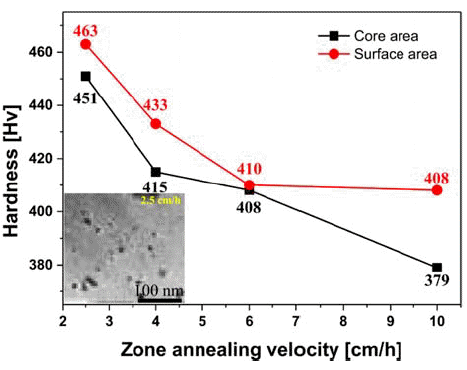
- 577 View
- 2 Download
- 1 Citations
-
 Abstract
Abstract
 PDF
PDF This study investigates the directional recrystallization behavior of Ni based oxide dispersion strengthened (ODS) alloy according to the zone annealing velocity. The zone annealing temperature is set as 1390°C, while the zone velocities are set as 2.5, 4, 6, and 10 cm/h, respectively. The initial microstructure observation of the as-extruded sample shows equiaxed grains of random orientation, with an average grain size of 530 nm. On the other hand, the zone annealed samples show a large deviation in grain size depending on the zone velocities. In particular, grains with a size of several millimeters are observed at 2.5-cm/h zone velocity. It is also found that the preferred orientation varies with the zone annealing velocity. On the basis of these results, this study discusses the role of zone velocities in the directional recrystallization of Ni base ODS alloy.
-
Citations
Citations to this article as recorded by- Directional recrystallisation processing: a review
Chao Yang, Ian Baker
International Materials Reviews.2021; 66(4): 256. CrossRef
- Directional recrystallisation processing: a review
- [Korean]
- Micro-deformation behavior of Brittle Hf-based Metallic Glass during Mechanical Milling
- Song-Yi Kim, A-Young Lee, Eun-Ji Cha, Do-Hun Kwon, Sung-Uk Hong, Min-Woo Lee, Hwi-Jun Kim, Min-Ha Lee
- J Korean Powder Metall Inst. 2018;25(3):246-250. Published online June 1, 2018
- DOI: https://doi.org/10.4150/KPMI.2018.25.3.246
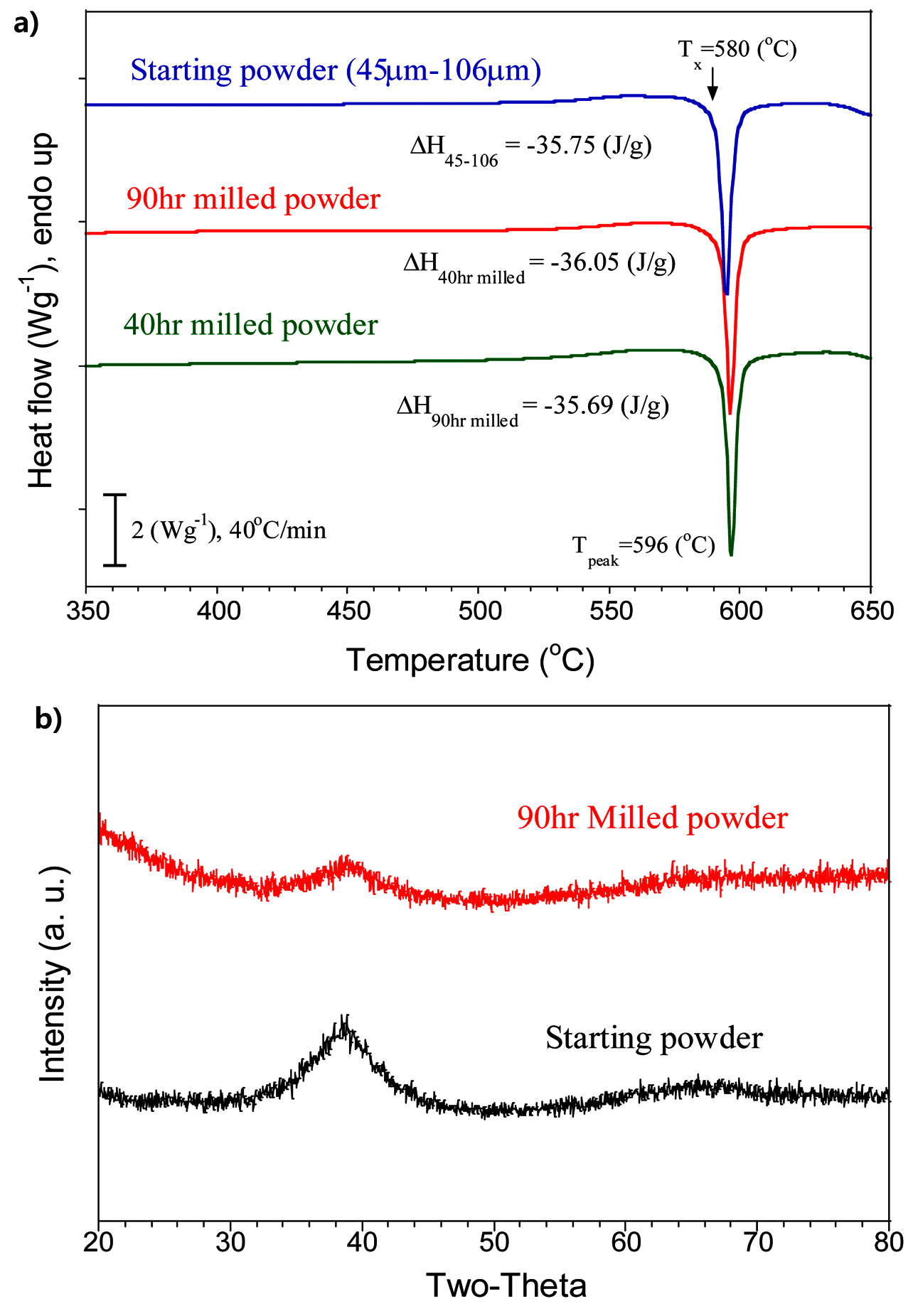
- 572 View
- 3 Download
-
 Abstract
Abstract
 PDF
PDF In this study, we investigate the deformation behavior of Hf44.5Cu27Ni13.5Nb5Al10 metallic glass powder under repeated compressive strain during mechanical milling. High-density (11.0 g/cc) Hf-based metallic glass powders are prepared using a gas atomization process. The relationship between the mechanical alloying time and microstructural change under phase transformation is evaluated for crystallization of the amorphous phase. Planetary mechanical milling is performed for 0, 40, or 90 h at 100 rpm. The amorphous structure of the Hf-based metallic glass powders during mechanical milling is analyzed using differential scanning calorimetry (DSC) and X-ray diffraction (XRD). Microstructural analysis of the Hf-based metallic glass powder deformed using mechanical milling reveals a layered structure with vein patterns at the fracture surface, which is observed in the fracture of bulk metallic glasses. We also study the crystallization behavior and the phase and microstructure transformations under isothermal heat treatment of the Hf-based metallic glass.
- [Korean]
- High Temperature Oxidation Behavior of Fe-14Cr Ferritic Oxide Dispersion Strengthened Steels Manufactured by Mechanical Alloying Process
- Young-Kyun Kim, Jong-Kwan Park, Hwi-Jun Kim, Man-Sik Kong, Kee-Ahn Lee
- J Korean Powder Metall Inst. 2017;24(2):133-140. Published online April 1, 2017
- DOI: https://doi.org/10.4150/KPMI.2017.24.2.133
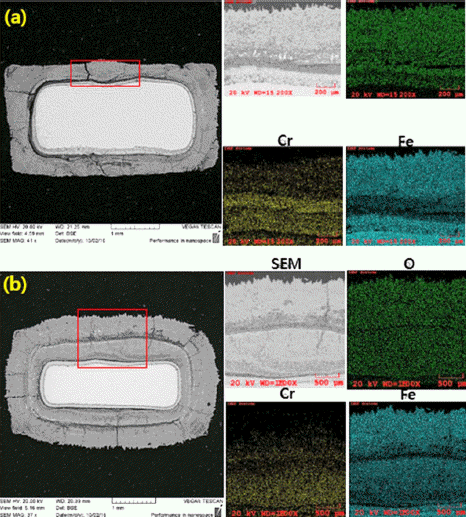
- 585 View
- 5 Download
- 1 Citations
-
 Abstract
Abstract
 PDF
PDF This study investigates the oxidation properties of Fe-14Cr ferritic oxide-dispersion-strengthened (ODS) steel at various high temperatures (900, 1000, and 1100°C for 24 h). The initial microstructure shows that no clear structural change occurs even under high-temperature heat treatment, and the average measured grain size is 0.4 and 1.1 μm for the as-fabricated and heat-treated specimens, respectively. Y–Ti–O nanoclusters 10–50 nm in size are observed. High-temperature oxidation results show that the weight increases by 0.27 and 0.29 mg/cm2 for the asfabricated and heat-treated (900°C) specimens, and by 0.47 and 0.50 mg/cm2 for the as-fabricated and heat-treated (1000°C) specimens, respectively. Further, after 24 h oxidation tests, the weight increases by 56.50 and 100.60 mg/cm2 for the as-fabricated and heat-treated (1100°C) specimens, respectively; the latter increase is approximately 100 times higher than that at 1000°C. Observation of the surface after the oxidation test shows that Cr2O3 is the main oxide on a specimen tested at 1000°C, whereas Fe2O3 and Fe3O4 phases also form on a specimen tested at 1100°C, where the weight increases rapidly. The high-temperature oxidation behavior of Fe-14Cr ODS steel is confirmed to be dominated by changes in the Cr2O3 layer and generation of Fe-based oxides through evaporation.
-
Citations
Citations to this article as recorded by- Microstructure and Wear Properties of Oxide Dispersion Strengthened Steel Powder Added Steel-Based Composite Material for Automotive Part
Young-Kyun Kim, Jong-Kwan Park, Kee-Ahn Lee
journal of Korean Powder Metallurgy Institute.2018; 25(1): 36. CrossRef
- Microstructure and Wear Properties of Oxide Dispersion Strengthened Steel Powder Added Steel-Based Composite Material for Automotive Part
- [Korean]
- Powder Metallurgy Process in Bulk Amorphous Alloys
- Hwi-Jun Kim, Jung-Chan Bae, Do-Hyang Kim
- J Korean Powder Metall Inst. 2006;13(6):387-395.
- DOI: https://doi.org/10.4150/KPMI.2006.13.6.387

- 326 View
- 0 Download
- [Korean]
- Synthesis and Properties of Amorphous Matrix Composites using Cu-based/Ni-based Amorphous Powders
- Taek-Soo Kim, Jin-Kyu Lee, Hwi-Jun Kim, Jung-Chan Bae
- J Korean Powder Metall Inst. 2005;12(6):406-412.
- DOI: https://doi.org/10.4150/KPMI.2005.12.6.406

- 760 View
- 5 Download
- 2 Citations
-
 Abstract
Abstract
 PDF
PDF - This work is to present a new synthesis of metallic glass (MG)/metallic glass (MG) composites using gas atomization and spark plasma sintering (SPS) processes. The MG powders of Cu_54Ni_6Zr_22Ti_18 (CuA) and Ni_59Zr_15Ti_13Nb_7Si_3Sn_2Al_1(NiA) as atomized consist of fully amorphous phases and present a different thermal behavior; T_g (glass transition temperature) and T_x (crystallization temperature) are 716K and 765K for the Cu base powder, but 836K and 890K for the Ni base ones, respectively. SPS process was used to consolidate the mixture of each amorphous powder, being CuA/10%NiA;and;NiA/10%CuA in weight. The resultant phases were Cu crystalline dispersed NiA matrix composites as well as NiA phase dispersed CuA matrix composites, depending on the SPS temperatures. Effect of the second phases embedded in the MG matrix was discussed on the micro-structure and mechanical properties.
-
Citations
Citations to this article as recorded by- Micro-deformation behavior of Brittle Hf-based Metallic Glass during Mechanical Milling
Song-Yi Kim, A-Young Lee, Eun-Ji Cha, Do-Hun Kwon, Sung-Uk Hong, Min-Woo Lee, Hwi-Jun Kim, Min-Ha Lee
journal of Korean Powder Metallurgy Institute.2018; 25(3): 246. CrossRef - Synthesis of Ni-based Metallic Glass Composite Fabricated by Spark Plasma Sintering
Song Yi Kim, Bo Kyeong Guem, Min Ha Lee, Bum Sung Kim
Journal of Korean Powder Metallurgy Institute.2013; 20(1): 33. CrossRef
- Micro-deformation behavior of Brittle Hf-based Metallic Glass during Mechanical Milling
TOP
 KPMI
KPMI


 First
First Prev
Prev


